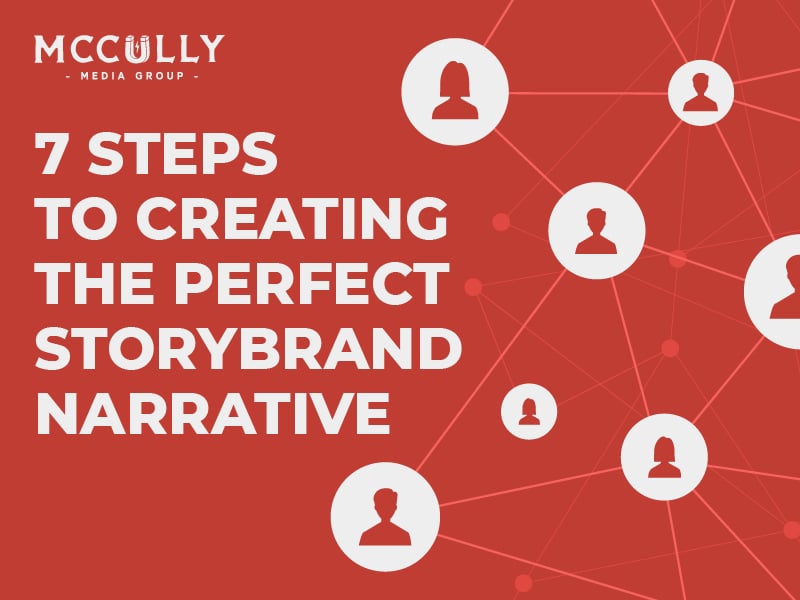It’s not enough to have a beautiful, click-worthy website. Winning companies draw their customers into a brand story through an impactful StoryBrand narrative. This is why marketing gurus like Seth Godin and Donald Miller advocate for storytelling as one of the most effective ways brands can engage their audience.
Donald Miller spent years studying the structure of stories and their importance in human culture and psychology. He then invented StoryBrand, a system that helps companies like yours perfect your messaging and marketing so that you can grow your business.
StoryBrand is simple to use and freely available here.
However, before you head over, read on for our step-by-step guide to crafting your brand narrative.
7 Steps for completing your Storybrand Narrative

1. Make your audience the hero
Repeat after me. You are not the hero of your brand story. Your customer is.
Once you understand that, you are well on your way to crafting the perfect StoryBrand narrative. Too many companies position themselves as knights in shining armor.
However, the best brands don’t see themselves as saviors. Instead, they are there to help the hero achieve something important.
Think of your company as Yoda and the customer as Luke Skywalker. To transform their lives, your customers don’t need you to do it for them. They just need your support to find the force that lives within them.
The cornerstone of making your audience the hero is understanding the hero’s journey. The hero’s journey is a universal story found in all cultures. The hero is called upon to leave their ordinary world and go on an adventure, resulting in a significant transformation.
Every hero’s journey has obstacles that get in the way of the protagonist achieving what they want.

2. Define their problems
For a potential customer to care about your message, you must consider some key questions:
What do they want? In other words, what motivates them? What is standing in their way?
Unless you have a clear idea of the problem and know the words your customers use to think or talk about it, you can’t make an emotional connection with them.
Problems have three components: the external, the internal, and the philosophical.
The external component is the problem on the surface level. For example, a lawn care company might identify the external problem as an overgrown yard.
The internal component is the customer’s feelings and emotions around the problem. For example, a homeowner with an overgrown yard might feel embarrassed by their unruly landscape and worry that their neighbors might look down on them.
The philosophical component comes down to what the customer might deserve. For example, the homeowner with an overgrown yard might work hard in their job all week. On the weekend they deserve to rest and enjoy their property, not spend hours pulling weeds and mowing the grass.
3. Be the guide to solving the problems
The best way to ensure you position your company as the guide and not the hero of the story is to use case studies in your marketing materials.
The reality is that people are bombarded by marketing messages. To stand out, you need to tell them what you can do for them, not how great your company is.
When crafting your case studies, use the words of your successful customers, not industry jargon. Include how they felt before and after their transformation.
4. Create a clear plan
Is your solution easy to use? Do you have a step-by-step plan that will help customers achieve their goals?
Above all, potential customers need to know exactly how they can work with you. The StoryBrand framework recommends outlining a three-step process for buying your product or service. It needs to be something as simple as the following example for a private gym:
Step 1 – You book a session with a personal trainer.
Step 2 – We create a fitness plan based on your unique needs.
Step 3 – You follow the plan all the way to your best body.
5. Include a clear call to action
Clarify your message. What action do you want the customer to take?
The call to action in your brand narrative should be clear and simple. Tell them where they need to go and what you want them to do there.
Focus on a single call to action per piece of content or webpage. This will help you to convert more leads because people won’t get overwhelmed with different options.
6. Discuss the consequences of failure
If your potential customers don’t act now to solve their problems, what could happen? What are they missing out on? What are they losing?
Your customers must understand the consequences of not acting on your message. Otherwise, they may continue to live their life the way they have for years.
7. Paint a picture of success
Make your potential customers care. What will they gain if they adopt your solution?

If they purchase your products and services, what will their life look like in six months or a year?
Ensure they can relate to it. For example, don’t just share stories about celebrities who have used your products. Show how the average person can achieve the same results.
Get started with the StoryBrand Framework
Content marketing can be a daunting task for any company, but it doesn’t have to be. The StoryBrand framework makes content and social media marketing easy and effective.
StoryBrand marketing helps brands create those stories and communicate their ideas more effectively. With each step of the StoryBrand narrative framework, you’ll be better positioned to attract your ideal customer and grow your business.
Use it to create better content that converts more leads with less effort.
If you would like help creating your brand story, connect with McCully Media Group here.
Learn More:
This Is How to Create a Profitable Content Marketing Strategy Using 7 Essential Steps





